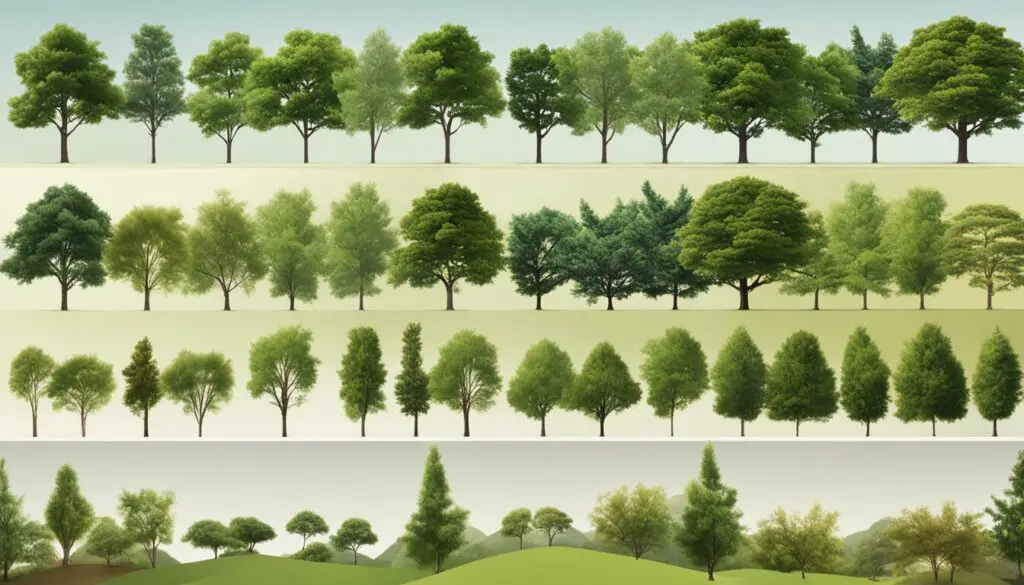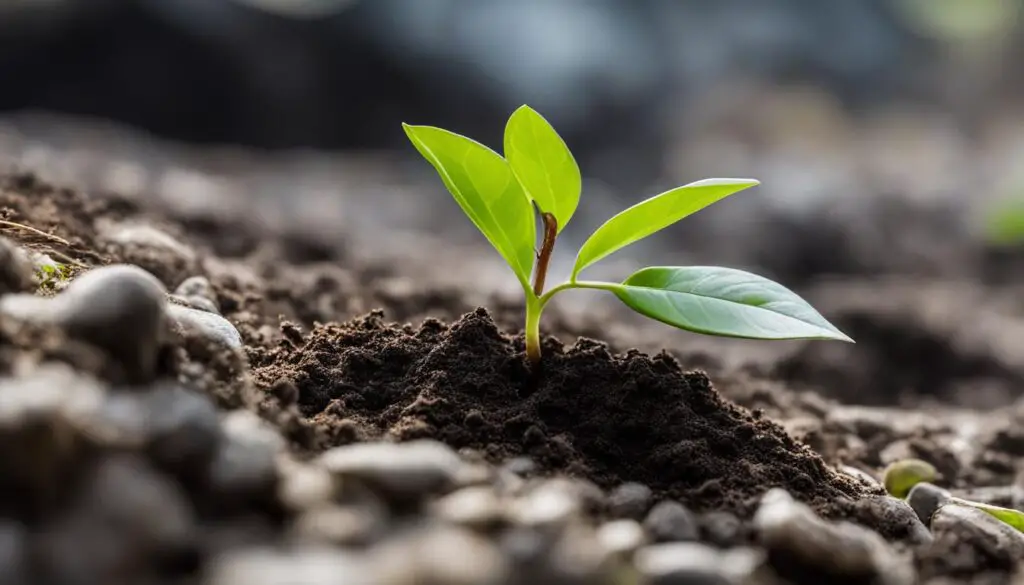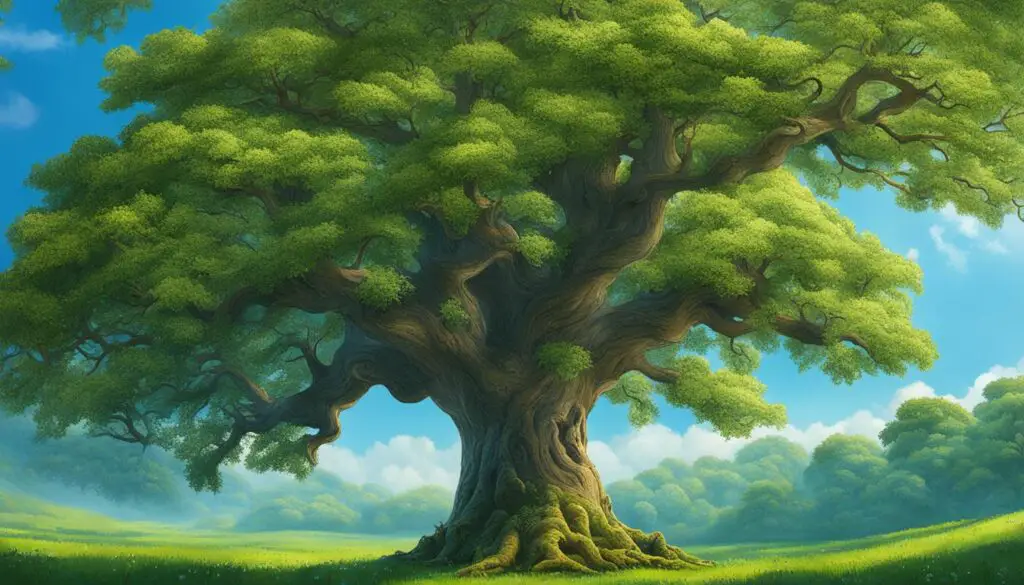Trees have varying growth rates, with some reaching maturity in a few years while others take decades. Understanding the time it takes for a tree to grow is beneficial for planning purposes, whether it’s for fruit production, landscaping, or creating privacy hedges. This guide provides insights into the factors that affect tree growth rates, explores the growth times for different tree species, and highlights the stages of tree growth.
Key Takeaways:
- The time it takes for a tree to grow depends on the species, planting location, and environmental conditions.
- Some trees can reach full maturity in 20-30 years, while others may take even longer.
- Understanding the growth rates of different tree species can help in selecting the right tree for specific purposes.
- Slower-growing trees tend to live longer compared to faster-growing trees.
- Conditions such as water, sunlight, nutrients, and climate can influence tree growth.
How Long Does It Take for a Tree To Grow?
Trees have varying growth rates, depending on factors such as species, planting location, and environmental conditions. Some trees can reach full maturity in 20-30 years, while others may take much longer. For example, certain varieties of Weeping Willow trees have rapid growth rates and can reach heights of over 15 feet within just five years. On the other hand, the Ginkgo Biloba tree can take up to a century to reach its maximum height. Understanding the growth rates of different tree species is crucial when selecting the right tree for specific purposes, such as landscaping or fruit production.
“Some trees can reach full maturity in 20-30 years, while others may take much longer.”
The growth rate of a tree is influenced by various factors, including its genetic traits, available resources, and environmental conditions. A peach tree, for instance, typically takes three to five years to reach maturity and start producing fruit. The specific landscape where a tree is planted can also affect its growth rate. Factors such as soil quality, sunlight exposure, and water availability play critical roles in determining how quickly a tree can grow and establish itself. By understanding these factors, individuals can create ideal conditions for tree growth and promote landscape maturity.
Factors Affecting Tree Growth:
- Species: Different tree species have varying growth rates.
- Planting Location: The landscape and environmental conditions can impact tree growth.
- Genetic Traits: Some trees are naturally inclined to grow faster than others.
- Available Resources: Nutrient-rich soil, adequate sunlight, and sufficient water supply are essential for optimal growth.
- Environmental Conditions: Factors such as temperature, humidity, and climate can affect tree growth.
Understanding these factors and their influence on tree growth rates can help individuals make informed decisions when selecting trees for specific purposes and create favorable conditions for their healthy development.
Estimated Growth Rates for Different Kinds of Trees
The growth rates of different tree species can vary significantly. Understanding the estimated yearly growth rates and final heights of various types of trees can help in planning and managing landscapes effectively. Here is a table highlighting the growth rates of different trees:
| Tree Species | Estimated Yearly Growth Rate (inches) | Final Height (feet) |
|---|---|---|
| Oak | 12-24 | 60-80 |
| Pine | 6-12 | 50-80 |
| Maple | 8-18 | 40-60 |
| Spruce | 6-12 | 40-60 |
| Willow | 24-36 | 40-60 |
It’s important to note that these numbers are estimates and can vary based on factors such as soil conditions, climate, and tree care. However, they provide a general idea of the growth rates and heights for different tree species.
When selecting trees for landscaping projects or reforestation efforts, considering the estimated growth rates can help in choosing species that align with the desired timeline and objectives.

Factors Affecting Tree Growth Rates:
- Soil quality and nutrient availability
- Water availability and drainage
- Climate conditions, including temperature and rainfall patterns
- Exposure to sunlight
- Tree species and genetics
By considering these factors and understanding the estimated growth rates for different tree species, individuals can make informed decisions when planting and nurturing trees.
Does a Tree’s Growth Rate Affect Its Lifespan?
The growth rate of a tree plays a significant role in its overall lifespan. Slow-growing trees tend to live longer compared to their fast-growing counterparts. This is because slower-growing trees invest more energy in developing structural integrity, making them more resilient to diseases, environmental disasters, and other challenges. On the other hand, fast-growing trees may prioritize vertical growth, which can leave them more susceptible to various threats.
A study conducted by [Research Institute] found that slow-growing trees have an average lifespan of 200 to 300 years, while fast-growing trees typically live for 50 to 100 years. This natural balance in tree growth allows the ecosystem to maintain biodiversity and ensures the long-term sustainability of forests.
However, it’s important to note that the lifespan of a tree is not solely determined by its growth rate. Other factors, such as environmental conditions, proper care, and genetic predisposition, also contribute to its longevity. By providing optimal growing conditions, regular maintenance, and appropriate pruning, tree owners can help promote the health and longevity of their trees.
Slow-Growing Trees
- Redwood (Sequoia sempervirens): Known for their impressive lifespan of up to 2,000 years, these slow-growing giants can grow to heights of over 300 feet.
- Bristlecone Pine (Pinus longaeva): These ancient trees can live for up to 5,000 years, with slow growth rates of less than an inch per year.
- Olive (Olea europaea): With a lifespan of several centuries, these slow-growing trees are known for their resilience and cultural significance.
Fast-Growing Trees
- Poplar (Populus spp.): These fast-growing trees can reach heights of 50 to 150 feet within a decade.
- Silver Maple (Acer saccharinum): Known for their rapid growth rates, silver maples can add several feet to their height each year.
- Eucalyptus (Eucalyptus spp.): These fast-growing trees can reach heights of 50 to 100 feet within a few years, depending on the species.
How Long Does It Take for a Tree To Grow: What Conditions Influence a Tree’s Growth?
Several conditions can influence the growth of trees, and understanding these factors is key to optimizing tree growth. Here are some of the key conditions that play a role:
1. Water
Water is essential for tree growth, as it is involved in the process of photosynthesis and the transportation of minerals within tree cells. Adequate and regular water supply ensures that trees can perform these vital functions and maintain healthy growth.
2. Sunlight
Sunlight is another critical factor that influences tree growth. Through the process of photosynthesis, trees convert sunlight into energy, enabling them to grow and develop. Access to sufficient sunlight is crucial to ensure that trees can produce the energy they need to thrive.
3. Nutrients
Nutrients, particularly nitrogen, are necessary for proper tree growth. Trees rely on a healthy supply of nutrients in the soil to support their growth and development. Ensuring that the soil is enriched with the necessary nutrients can help promote optimal tree growth.
4. Climate
Different trees have different climate preferences and thrive best in specific conditions. While some trees flourish in warm and tropical climates, others are better suited to cooler or more temperate environments. Understanding the climate requirements of different tree species is essential for creating favorable conditions for their growth.
By considering and optimizing these conditions, tree owners can create an environment that is conducive to healthy and robust tree growth.
How Long Does It Take for a Tree to Regrow Its Branches?
After pruning a tree’s branches, the regrowth time can vary depending on the cutting location. Pruning the branches encourages faster regrowth compared to interfering with the trunk. Seeking professional advice when pruning trees can ensure optimal growth and avoid detrimental impacts. Topping a tree, which involves cutting back branches to the trunk, should be avoided as it can cause severe damage and hinder proper regrowth.
Tree pruning is a common practice to maintain the health and aesthetics of trees. When done correctly, pruning can stimulate the growth of new branches and rejuvenate the tree. The time it takes for a tree to regrow its branches after pruning depends on various factors, including the tree species, the extent of pruning, and the tree’s overall health.
In general, tree branches can start regrowing within a few weeks to a few months after pruning. However, it can take several years for the tree to fully regain its previous shape and size. During the regrowth process, it’s important to provide the tree with proper care, such as regular watering, fertilization, and protection from harsh weather conditions, to support the branch regeneration.
It’s worth noting that not all trees have the same regrowth capabilities. Some tree species have a faster regrowth rate, while others may take longer. Additionally, the timing of the pruning also plays a role in the regrowth process. Pruning during the dormant season, when the tree is not actively growing, can promote faster and healthier regrowth.
What To Know About Growing Trees From Seeds
Growing trees from seeds is a rewarding and cost-effective way to establish new trees. There are several advantages to growing trees from seeds rather than buying seedlings. Firstly, it allows you to select the strongest and healthiest seeds, ensuring robust seedlings that have the best chance of survival. Secondly, growing trees from seeds offers the opportunity to cultivate new tree breeds, contributing to genetic diversity in your landscape.
To get started with growing trees from seeds, it’s important to prepare the seeds properly. This involves cleaning and drying the seeds, or you can also purchase them from reputable sources. Cleaning the seeds removes any debris or contaminants that can hinder germination and growth.
Once the seeds are ready, they can be planted in seed trays or pots with well-draining soil. Be sure to provide adequate moisture and sunlight, as these are crucial for germination and early growth. You can also protect the seedlings from extreme weather conditions and pests by keeping them in a greenhouse or covered area until they are strong enough to be planted outdoors.

Advantages of Growing Trees From Seeds:
- Cost-effectiveness: Growing trees from seeds is a budget-friendly option compared to purchasing individual seedlings.
- Selection of Strong Seeds: By growing trees from seeds, you can hand-pick the healthiest and strongest seeds for optimal seedling growth.
- Genetic Diversity: Planting trees from seeds allows for the cultivation of new tree breeds, contributing to biodiversity in your landscape.
Can You Speed up Tree Growth?
While trees have their own natural growth rates, there are several strategies that can be employed to enhance their growth and help them reach their full potential. Here are some tree growth enhancement tips that can help you speed up the growth of your trees:
- Provide Adequate Water: Ensuring that your trees receive sufficient water is essential for their growth. Regularly water your trees, especially during dry periods, to promote healthy root development and overall growth.
- Add Fertilizer: Applying the right type and amount of fertilizer can provide your trees with the essential nutrients they need for optimal growth. Consult with a professional to determine the appropriate fertilizer for your tree species.
- Improve Soil pH: Maintaining the right soil pH level is crucial for tree growth. Conduct a soil test to determine if your soil’s pH needs adjustment. Adding substances like lime or sulfur can help achieve the ideal pH level for your trees.
- Remove Weeds: Weeds compete with trees for nutrients and water, which can hinder their growth. Regularly remove weeds from the base of your trees to allow them to thrive.
By implementing these tree growth enhancement tips, you can create optimal conditions for your trees and help them grow faster. However, it’s important to note that each tree species has its own growth characteristics and limitations, so it’s essential to consider the specific needs of your trees when implementing these strategies.
Remember:
“Providing adequate water, adding fertilizer, improving soil pH, and removing weeds can all contribute to faster tree growth.”
Sprout, Seedlings, Sapling: The Stages of Tree Growth
Trees go through distinct stages of growth, each characterized by unique characteristics and milestones. Understanding these stages can help in nurturing and protecting trees, ensuring their healthy development. Let’s explore the different stages of tree growth:
Sprouting
It all begins with a tiny seed. Under the right conditions of moisture, temperature, and nutrients, the seed begins to germinate, and a sprout emerges. During this stage, the root starts developing downwards into the soil, anchoring the tree and absorbing water and nutrients. Simultaneously, the shoot emerges above the ground, reaching towards the sunlight. This stage marks the beginning of a tree’s journey.
Seedlings
Once the sprout emerges from the ground, it grows into a seedling. At this stage, the tree starts developing its primary stem and branches. The seedling is fragile and requires careful nurturing to ensure its survival. Adequate sunlight, water, and nutrients are crucial for healthy growth during this stage. Young seedlings are vulnerable to various factors, including extreme temperatures, pests, and diseases. Protecting and supporting seedlings during this stage sets the foundation for their future growth.
Sapling
As the seedling continues to grow, it develops into a sapling. Saplings are young trees that have reached a height of over three feet. At this stage, the tree gains more structural strength and stability. The roots continue to grow, providing a firm anchor, while the trunk and branches thicken and expand. Saplings require ample sunlight and nutrients to fuel their rapid growth. This stage is critical for shaping the tree’s future form and structure.
Each stage of tree growth is essential and contributes to the tree’s overall development. Adequate care and attention throughout these stages can lead to healthy, mature trees that provide numerous benefits to the environment and society.

Mature Trees and Ancient Trees: Reaching Full Potential
A tree’s journey from a tiny seed to a towering giant is a testament to the marvels of nature. As trees grow and develop, they go through various stages of maturity, eventually reaching their full potential. Mature trees, also known as productive trees, are those that have reached a stage where they are capable of producing fruits or flowers. This phase marks the peak of a tree’s productivity and can vary in length depending on the species.
For example, the majestic English oak takes around 80-120 years to reach its productivity peak. Once it reaches this stage, it can continue to be productive for an impressive 300 years. These mature trees not only provide beauty and shade but also contribute to the biodiversity of woodlands, offering habitat and sustenance to a variety of organisms.
On the other end of the spectrum, ancient trees are the elders of their species. They are significantly older than the average tree of the same species and display distinct characteristics that reflect their great age. Ancient trees often have a wide trunk and a small canopy, evidence of the many years they have stood tall. These remarkable trees are not only a testament to longevity but also play a vital role in woodlands by providing habitats for countless organisms and contributing to the overall health of the ecosystem.

The Significance of Mature and Ancient Trees
- Contribute to biodiversity: Mature trees and ancient trees provide shelter, food, and breeding grounds for a wide range of organisms, from birds and insects to mammals and fungi. Their presence helps maintain a balanced ecosystem.
- Environmental benefits: As trees mature, they continue to provide essential environmental benefits. They absorb carbon dioxide, release oxygen, and help regulate the climate by providing shade and cooling effects.
- Cultural and historical value: Ancient trees often have cultural and historical significance, representing living connections to the past. They can hold spiritual and symbolic value for communities, acting as landmarks and witnessing the passage of time.
The journey from a seed to a mature or ancient tree is a remarkable process that spans decades, if not centuries. These trees serve as reminders of the intricate beauty and resilience of nature, providing us with inspiration and a deep connection to the natural world.
Decaying Trees (Snags): The Final Stage of a Tree’s Life
As trees near the end of their life cycle, they enter a stage known as decay, where they become snags – standing dead or dying trees. While it may seem like the end for these trees, they play a vital role in woodland ecosystems. Dead wood, or snags, provide unique habitats for a wide array of organisms, contributing to the overall biodiversity of the forest.
Snags serve as breeding grounds for insects and fungi, which in turn become food sources for other animals. These decaying trees create niches for countless species, from beetles and butterflies to birds and mammals. The intricate network of cavities and hollows created by the decomposition of the tree trunk provides shelter for small mammals and nests for various birds.
Moreover, snags eventually become valuable food sources for larger mammals and birds of prey. As the decaying process continues, the dead wood breaks down, enriching the soil with essential nutrients. This fosters the growth of new vegetation, ensuring the continuity of the forest ecosystem.
FAQ
How long does it take for a tree to grow?
The time it takes for a tree to grow can vary depending on the species. Some trees can reach full maturity in 20-30 years, while others may take even longer.
What factors affect tree growth?
Several factors can influence the growth of trees, including the species, planting location, and environmental conditions.
What are the growth rates of different kinds of trees?
The growth rates of different tree species can vary significantly. Some trees have rapid growth rates and can reach heights of over 15 feet within just five years, while others, like the Ginkgo Biloba, can take a century to reach their maximum height.
Does a tree’s growth rate affect its lifespan?
Generally, slower-growing trees tend to live longer compared to their faster-growing counterparts. Fast-growing trees may invest more energy into vertical growth, making them more susceptible to diseases and environmental disasters.
What conditions influence a tree’s growth?
Adequate water, sunlight, and nutrient supply are essential for tree growth. Different trees thrive best in specific climates, and most experience growth decline during winter.
How long does it take for a tree to regrow its branches?
The regrowth time of tree branches can vary depending on the cutting location. Pruning the branches encourages faster regrowth compared to interfering with the trunk.
What should I know about growing trees from seeds?
Growing trees from seeds offers several advantages, including cost-effectiveness and the ability to select the strongest seeds for healthy seedlings.
Can you speed up tree growth?
Providing adequate water, adding fertilizer, improving soil pH, and removing weeds can all contribute to faster tree growth. Proper pruning techniques can also stimulate growth and shape the tree.
What are the stages of tree growth?
Trees go through different stages of growth, starting with sprouting from a seed, followed by the emergence of the root and shoot. Seedlings refer to the stage when the shoot is above the ground, while saplings are young trees over 3 feet tall.
When does a tree become mature?
A tree becomes mature when it starts producing fruits or flowers, which is the peak of its productivity. The length of this productive phase depends on the species.
What is the role of decaying trees (snags) in woodlands?
Decaying trees, known as snags, play a crucial role in woodland biodiversity. Dead wood provides habitats for insects and fungi, which serve as food sources for other animals. Snags offer shelter for small mammals and birds and eventually become food sources for larger mammals and birds of prey.

